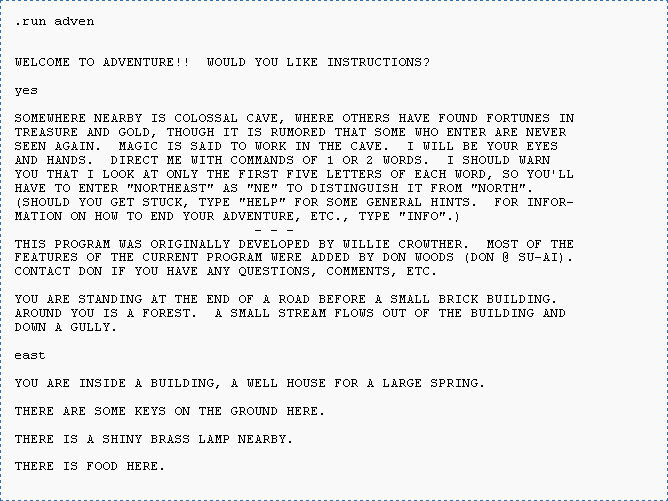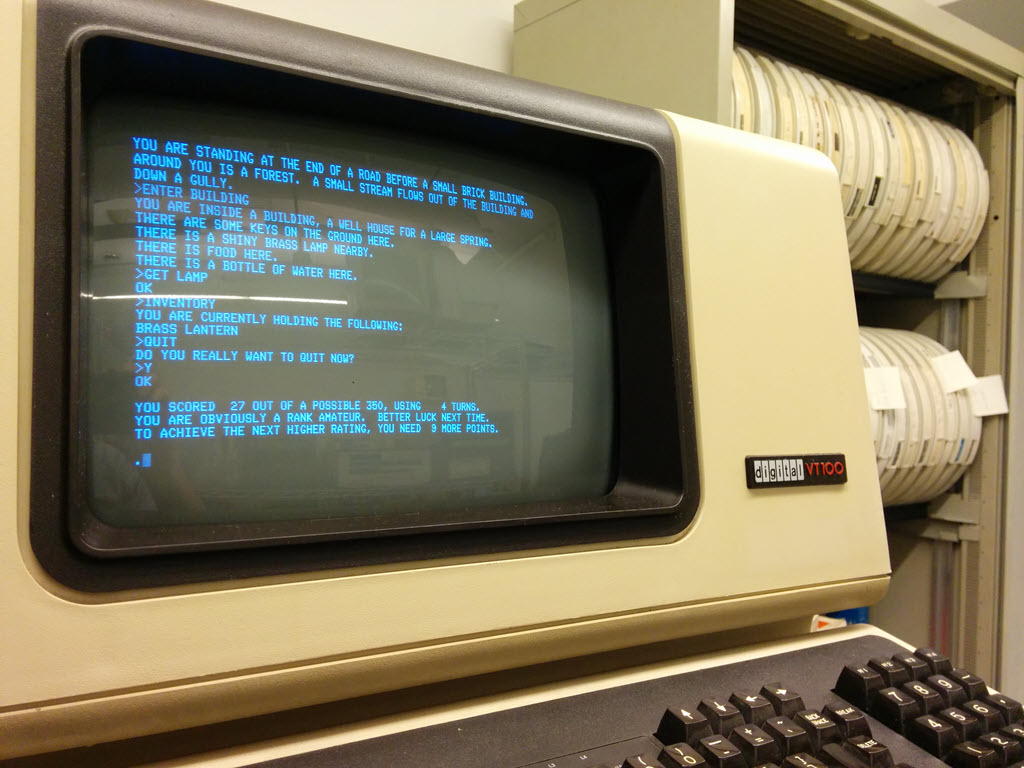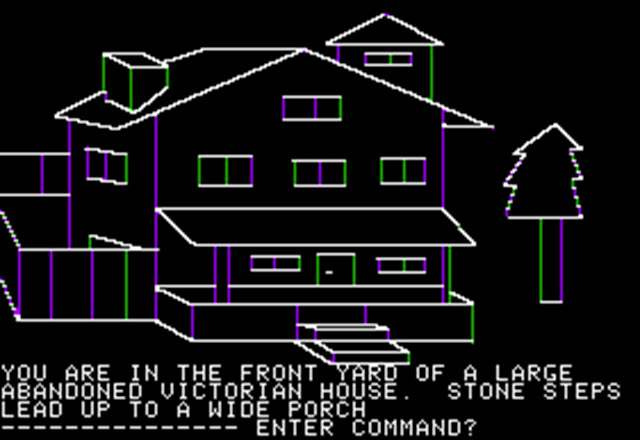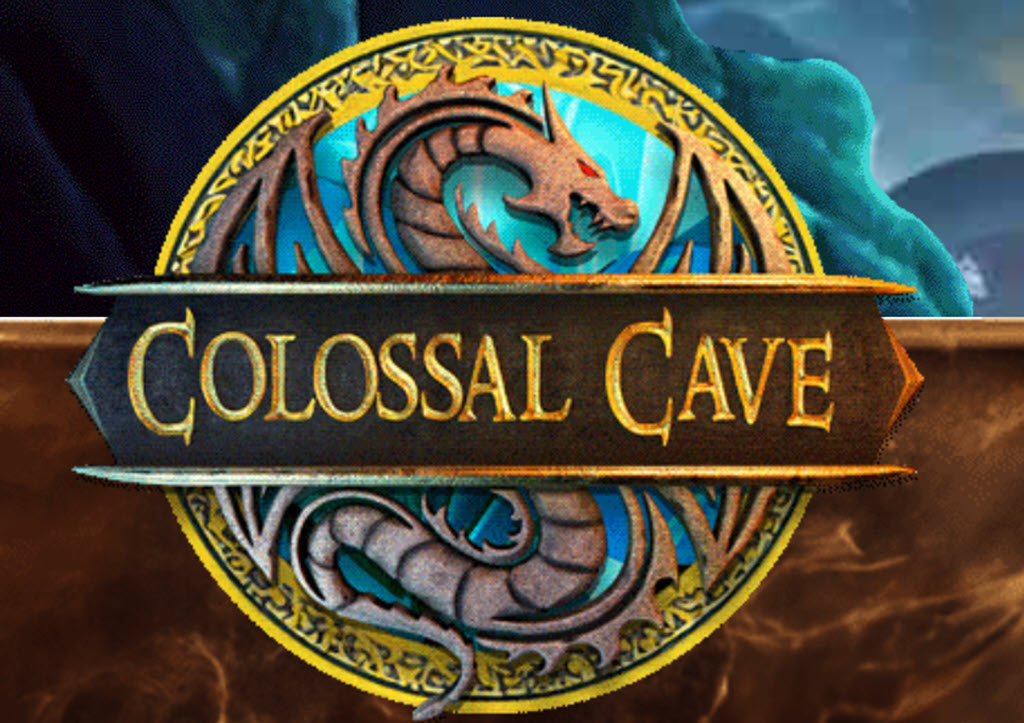
Near the beginning of Veilpiercer, our plucky hero Cabalynne takes an elevator into the bowels of a secret complex hidden under the Denver airport, joining a group of employees who will be disassembling obsolete equipment for giant tech corporation Arrgle. Chapter 4 begins:
“Fifty Recyclopath employees were led into the Arrgle complex through a maze of twisty little passages, all alike, and into a cavernous hangar filled with blinking servers and an unceasing hum of air conditioning.”
The twisty little passages are well known to people who were present at the birth of computer gaming in the mid-1970s.
Colossal Cave Adventure was one of the first text-based computer games, first released on mainframe computers in 1976 – mainframes because personal computers didn’t exist yet, and text-based because computers didn’t do pictures yet. Players would type one or two word commands and get a description of rooms in a mysterious cave.

This is what it looked like in 1976 on an oscilloscope-size screen with glowing white letters.

Colossal Cave is forever wedded in our minds to memories of Xerox PARC.
Jim spent two summers in 1976/77 at Palo Alto Research Center (PARC), the groundbreaking Xerox division tasked with creating computer technology. PARC did foundational work on things that we came to take for granted – laser printers, the computer mouse, and interfaces with overlapping windows and popup menus. At that time the standard way to use a computer was to hand a box of punch cards to an operator and wait for a printout. What was happening at Xerox PARC was magical.
Jim got a job at Xerox PARC through his professor, Carver Mead, who was working on truly geeky stuff: chip design. During his time at PARC, Jim wrote a software program called ICARUS, an interactive graphics program to help design integrated circuits. This is more or less the most nerdly thing you’ve ever learned about anyone ever. Fun fact: Dick Lyon used ICARUS at PARC to invent the first optical mouse in 1980.
The first personal computer, the Alto, was developed at PARC, complete with mouse and rudimentary graphics. Ethernet was being used for the first time to send data back and forth and play multi-person games. In MazeWar, you were a giant hovering eye roaming a maze and shooting at other people. One of the first first-person shooters. And it was multiplayer! There was also Alto Trek, a space strategy game where you tried to control as many star systems as you could, with simple line drawings for spaceships (pretty much a triangle) and dots for stars.
But it was Colossal Cave that was the most addictive for us. Bruce visited Jim in Palo Alto during the summer of 1977 and we spent hours playing it, trying to figure out how to get all the points, or even what commands would work (there are no instructions, you were just supposed to figure it out). Jim eventually became a grandmaster (all 350 points) but only by cheating (i.e. getting other people to tell him the tricks). The final point, number 350, the one that conferred bragging rights, is only awarded if a player happens to move a copy of Spelunking Magazine from one maze chamber to another. Sadistic game play at its best.
Colossal Cave Adventure was ubiquitous in the newly emerging world of computer programming at the end of the 1970s and turned into a legend, one of the most influential games of all time. It was the direct inspiration for Zork, the game that launched Infocom as one of the first and most inventive commercial computer game companies. It’s the foundation of the interactive fiction, adventure, and action-adventure game genres. The creators of the Carmen Sandiego series said they were inspired by the idea of transforming Adventure’s movement around caverns into a global treasure hunt.
There is a maze in the game with ten rooms. No matter what direction you move, the same description appears: “YOU ARE IN A MAZE OF TWISTY LITTLE PASSAGES, ALL ALIKE.” Players had to map the maze by dropping objects and observing what sequence led back to them. It was infuriating to enter the maze unintentionally. Every Adventure player remembers the goddam maze.
Wikipedia says:
“The phrase “you are in a maze of twisty little passages, all alike” has become memorialized and popularized in the hacker culture. . . . This phrase came to signify a situation when whatever action is taken does not change the result.”
When Nick Montfort wrote a history of interactive gaming in 2003, what better title could there be than “Twisty Little Passages”?
Colossal Cave had a resurgence of attention last year, thanks to veteran game designers Roberta & Ken Williams.

In 1980 Roberta and Ken Williams released Mystery House, considered to be the first graphical adventure game because of its line drawings. If you look at the screenshot above, it’s obvious that the primary influence was Colossal Cave Adventure.
Roberta and Ken founded Sierra Online and became pioneers in computer gaming, always pushing the envelope of computer graphics with the Kings Quest series, Phantasmagoria, and many other games. They left the company at the end of the 90s and took a sabbatical that turned into a twenty year retirement.
But they decided to return to the game industry one more time. Last year, their new studio Cygnus Entertainment released its first game.

It’s a turn-for-turn remake of Colossal Cave Adventure with fully realized 3D graphics, playable as a flatscreen computer or console game but best enjoyed as an immersive VR experience on Quest headsets.
For a few old-timers, then, Cabalynne’s trip into a maze of twisty little passages conjures up flashes of nostalgia and images of a confusing cave.
For everyone else, picture blank white corridors and unmarked doors as Cabalynne heads into the secret server complex under the Denver airport. Which definitely isn’t real, by the way; everyone knows the hiding places under the airport are used for gargoyle breeding grounds and the headquarters of the Illuminati.
